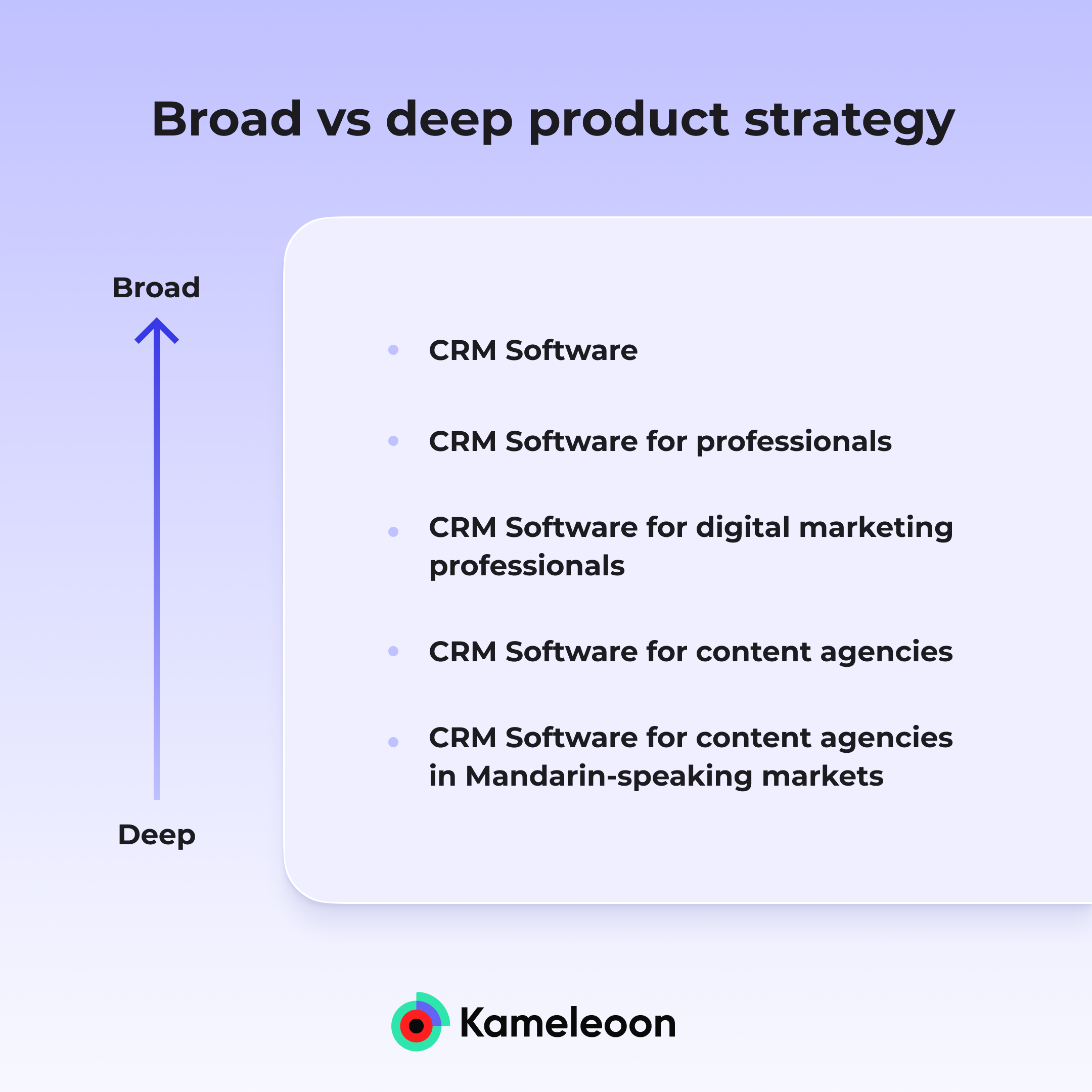
Deep vs. broad SaaS product strategy — how can product teams determine what's best for growth?
SaaS businesses face a choice when it comes to product growth strategies: go deep or go broad. Going deep means digging into increasingly specific niches within your product area, a trend we're seeing in the SaaS world. On the other hand, going broad involves creating a whole set of related or adjacent products to cater to a general market (think: ecosystem plays). Imagine these strategies on a spectrum, starting broad, with, for example, CRM targeting professionals and then getting more niche, e.g., a CRM for content agencies in Mandarin-speaking markets.

So, the question lingers—should businesses embark on a deep dive or cast a wide net for growth? To shed light on this nuanced decision-making journey, we asked six seasoned product leaders to share their arsenal of tools and methodologies for discerning the optimal product strategy.
Here’s what they had to say.
Should you grow?
I imagine this heading has caught you off guard; after all, it’s a blog post billed as helping you discern which product strategy is best for growth. But as Phil argues below, working out if growth is the right goal is an imperative first step;
In the last few years, cheap access to capital has meant that many companies pursued a strategy of growth first, with revenue and profitability as lower priorities. In the current climate, that has shifted as future funding becomes less certain.
While these are understandable priorities driven by external forces, I would argue that focusing on profitable growth should always be the focus as it helps avoid the boom-and-bust layoff cycles and also means the value your product is delivering is clear, as the best feedback is someone paying what it is worth.
To decide whether to focus on a deep or broad product strategy, the answer must be “it depends.” First, we need to consider what growth means.
- Is it more users, more customers, more revenue, or something else?
- And how much growth? 1%, 10%, 100% or 1000%?
The answer to these questions will help define what strategy makes the most sense.
Before we get into the details of which product strategy you should follow, Chris has some words of warning about getting caught up in the broad vs. deep discussion, especially when it comes to SaaS.
Analyze the current context
To start appraising which product strategy is best, you need to gather data and analyze the environment in which you operate to place your decision into context, as Rana expands on.
Figuring out the context and then asking yourself, what is the one thing that, if addressed, could ignite growth?
Phil provides some more questions to help assess your current environment.
- Is your current core market saturated?
- Are there closely related customer problems you can address in your product that are under-served?
- Do your existing customers have other problems that are a little further away, but because they trust you, they are likely to buy from you?
- Are there other customers you can reach easily with the same or a different offer?
- Can you leverage your unfair advantage through a unique capability or technology to deliver value that no one else can?
If you can't answer these sorts of questions, then you don't have the information you need to decide what to do.
Specific tools, data, and frameworks can be employed to help you establish which is the best product strategy at any given moment, but there are pitfalls, as Ambar shares.
A broad strategy involves diversifying the product portfolio. Here, teams must employ a robust market analysis framework, identifying adjacencies and cross-selling opportunities. The Ansoff Matrix can guide decisions on market penetration, development, or diversification. For example, Stripe expanded beyond payment processing into corporate cards to serve an adjacent market. Experiment with MVPs and A/B testing to validate new ideas, but beware of brand dilution and resource overextension.
In both strategies, data-driven decision-making is key. But teams must balance data with creative insight and not shy away from bold moves when justified.
Aligning product strategy with business goals
The product team shouldn’t work in isolation from the rest of the business, ideally, there’s cross-functional collaboration among product, marketing, and sales teams. However, knowing what other teams are planning can be harder than it sounds. That’s where alignment with a North Star goal can help ensure everyone is pulling in the same direction. Navya recommends using the Three Horizons framework to create cross-functional alignment between teams, taking into account business objectives, market dynamics, and strategy;
Leveraging the Three Horizon framework aids in this decision-making process. This model categorizes innovations into ‘core,’ ‘adjacencies,’ and ‘moonshots’ based on time horizon and strategic intent.
Using this framework helps to foster alignment between product teams and business objectives. Encouraging cross-functional collaboration among product, marketing, and sales teams helps align the product roadmap with market needs and business objectives.
Product leaders should prioritize data-driven insights, market analysis, and customer feedback to categorize innovations accurately. While a deep strategy may suit established markets, a broad approach offers adaptability in swiftly evolving landscapes. Balancing short-term gains with long-term disruptive initiatives ensures sustainable growth. Agile iteration and continuous evaluation within the framework ensure flexibility to adapt to changing market conditions.
Ultimately, revisiting the Three Horizon framework regularly allows for adjustments, ensuring the strategy remains aligned with evolving market dynamics. This approach empowers product teams to make informed decisions that foster innovation while maintaining competitiveness in the ever-evolving SaaS landscape.
Iterative roadmapping and agile experimentation
You should now have tons of ideas for expanding and deepening your product. But which strategy will result in the growth you are targeting? It’s time to weigh out your options but not with opinions; as Phil says.
Markets, customers, and business goals — none of them are static, and nor should your product strategy be. While we’re not suggesting you throw in the towel and switch up strategies at the slightest sign of change, what you plan needs to remain flexible and malleable to the specific nature and context you find yourself in. It’s also not always a binary decision, as Ambar shows.
Sumaiya goes on to outline a four-point approach that product leaders should employ to remain agile in ongoing context gathering, monitoring, and assessment of their product strategy.
2. Strategic Alignment with Market Trends. Align product strategy with current market trends. Deep strategies may focus on refining a niche, while broad strategies cater to evolving market demands. Regular market analysis ensures that the chosen strategy resonates with customer expectations, promoting sustainable growth.
3. Balancing Resources and Customer Value. Consider resource allocation in relation to customer value. Deep strategies optimize resources for core product excellence, while broad strategies allocate resources for diversification. Striking a balance ensures sustained growth without compromising the quality of the core product.
4. Iterative Roadmapping and Agile Experimentation Frameworks. Develop an iterative roadmap based on continuous user feedback. Regularly reassessing the roadmap ensures that the chosen strategy remains aligned with user expectations and market dynamics. Then, implement agile experimentation to test the impact of deep or broad strategies. A/B testing allows teams to iterate rapidly, measuring user response to core product improvements or new feature introductions.
Rana suggests some additional elements to add to your strategy to ensure things stay on track.
Summary
Here’s how to decide whether to pursue a broad vs. deep SaaS product strategy:
- Establish what type of growth you are after. Different growth goals will influence your product strategy, e.g., new customer growth vs. profit growth.
- Analyze the current context. Seek data to answer questions about the market, competition, and customer needs. You can use frameworks such as Jobs-to-be-Done and The Ansoff Matrix.
- Align the product strategy with business goals. Use the Three Horizons framework to align product strategy with the business goals (and their timeframes) and other teams across the company.
- Use iterative roadmapping and agile experimentation to evaluate your decisions and course-correct to ensure you reach your goals.
Thanks to all the contributors
- Phil Hornby, Founder and Product Coach at for product people
- Chris Kiklas, Vice President of Product Management at UKG
- Rana Mumtaz, Product Growth Executive
- Ambar Shrivastava, Founder at CoverDoc.ai
- Navya Rehani Gupta, Chief Product Officer at Peek
- Sumaiya Noor, Advisor and fractional CPO
If you’d like to keep up with all the industry's top experimentation-related news, sign up for our newsletter or find industry leaders to follow in our Expert Directory.








